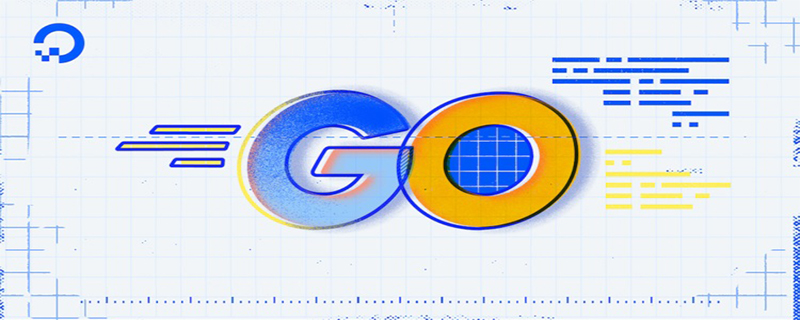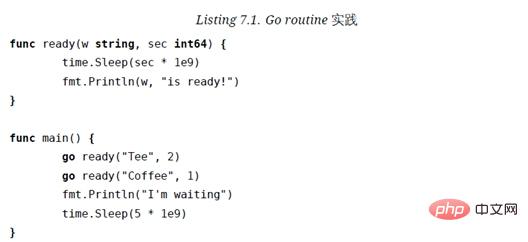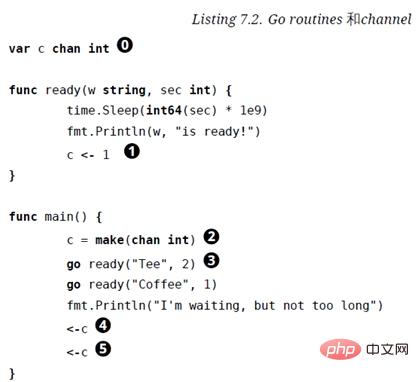Introduction to concurrency in go language (with code)

When asked why we use Go language, we must mention the concurrent programming of Go language. Writing very cumbersome and complex concurrent programs in C language always seems so convenient in Go language.
Concurrent programs in Go rely on two things: goroutine and channel
Understand what goroutine is?
For beginners Scholars, goroutine can be directly understood as a thread. When you call go on a function and start a goroutine, it is equivalent to starting a thread to execute the function.
In fact, a goroutine is not equivalent to a thread. The emergence of goroutine is to replace the original thread concept and become the smallest scheduling unit.
Once a goroutine is run, it first searches for the leading thread. If the thread is blocked, it will be assigned to an idle thread. If there is no idle thread, a new thread will be created. Note that when the goroutine completes execution, the thread will not be recycled and pushed out, but will become an idle thread.
The use of goroutine
is very simple to use, add a go
f(11)
before the functiongo f(11) //This is to let the f() function run as a goroutine
But go has a shortcoming. What should I do if the main thread has to wait for a goroutine to finish before processing? Take an example from "Learning Go Language".

Why should line 18 sleep? This is to wait for the above two go ready processes to be completed.
Okay, here comes a requirement: after a goroutine ends, data must be transmitted to the main thread to tell the main thread that the goroutine has ended.
The concept of channel is introduced here
Use of channel
The meaning of channel can be understood in vernacular like this: Main The thread tells everyone that you can open a goroutine, but I opened a pipe in my main thread. After you finish what you want to do, stuff something into the pipe to tell me that you have completed it.
The above example can be changed to:

Some information obtained from this program:
1 channel only You can use make to create
The basic format is c := make(chan int)
int indicates what type of data this pipe can transmit
2 The operation of inserting data into the channel
c
Is it very vivid?
3 Outputting data from the channel
4 Why does it need to be output twice (lines 4 and 5?)
Because 2 and 3 start two Each goroutine outputs a 1 to the pipe, so the main thread has to receive it twice to indicate that both goroutines have ended.
Further understanding of channel:
Channel is divided into two types: one with buffer and one without buffer. The default is no buffer.
ci := make(chan int) //No buffer
cj := make(chan int, 0) //No buffer
cs := make(chan int, 100) //With buffer
Buffered channel , so you should pay attention to "put" before "get"
Unbuffered channel, so pay attention to "get" before "put"
Also output hello world first, use buffered channel The channel and unbuffered channel are as follows:
Buffered channel:
var a string
var c = make(chan int, 10)
func f() {
a = "hello, world"
c <- 0
}
func main() {
go f()
<-c
print(a)
}There is a buffer here, so the operation of putting data is c<- 0 precedes the data fetch operation <-c
Unbuffered channel:
var a string
var c = make(chan int)
func f() {
a = "hello, world"
<-c
}
func main() {
go f()
c <- 0
print(a)
}Since c is an unbuffered channel, the fetch operation must be guaranteed
Recommendation: golang tutorial column
The above is the detailed content of Introduction to concurrency in go language (with code). For more information, please follow other related articles on the PHP Chinese website!

Hot AI Tools

Undresser.AI Undress
AI-powered app for creating realistic nude photos

AI Clothes Remover
Online AI tool for removing clothes from photos.

Undress AI Tool
Undress images for free

Clothoff.io
AI clothes remover

Video Face Swap
Swap faces in any video effortlessly with our completely free AI face swap tool!

Hot Article

Hot Tools

Notepad++7.3.1
Easy-to-use and free code editor

SublimeText3 Chinese version
Chinese version, very easy to use

Zend Studio 13.0.1
Powerful PHP integrated development environment

Dreamweaver CS6
Visual web development tools

SublimeText3 Mac version
God-level code editing software (SublimeText3)

Hot Topics
 1387
1387
 52
52
 How to send Go WebSocket messages?
Jun 03, 2024 pm 04:53 PM
How to send Go WebSocket messages?
Jun 03, 2024 pm 04:53 PM
In Go, WebSocket messages can be sent using the gorilla/websocket package. Specific steps: Establish a WebSocket connection. Send a text message: Call WriteMessage(websocket.TextMessage,[]byte("Message")). Send a binary message: call WriteMessage(websocket.BinaryMessage,[]byte{1,2,3}).
 Application of concurrency and coroutines in Golang API design
May 07, 2024 pm 06:51 PM
Application of concurrency and coroutines in Golang API design
May 07, 2024 pm 06:51 PM
Concurrency and coroutines are used in GoAPI design for: High-performance processing: Processing multiple requests simultaneously to improve performance. Asynchronous processing: Use coroutines to process tasks (such as sending emails) asynchronously, releasing the main thread. Stream processing: Use coroutines to efficiently process data streams (such as database reads).
 How to match timestamps using regular expressions in Go?
Jun 02, 2024 am 09:00 AM
How to match timestamps using regular expressions in Go?
Jun 02, 2024 am 09:00 AM
In Go, you can use regular expressions to match timestamps: compile a regular expression string, such as the one used to match ISO8601 timestamps: ^\d{4}-\d{2}-\d{2}T \d{2}:\d{2}:\d{2}(\.\d+)?(Z|[+-][0-9]{2}:[0-9]{2})$ . Use the regexp.MatchString function to check if a string matches a regular expression.
 The difference between Golang and Go language
May 31, 2024 pm 08:10 PM
The difference between Golang and Go language
May 31, 2024 pm 08:10 PM
Go and the Go language are different entities with different characteristics. Go (also known as Golang) is known for its concurrency, fast compilation speed, memory management, and cross-platform advantages. Disadvantages of the Go language include a less rich ecosystem than other languages, a stricter syntax, and a lack of dynamic typing.
 How to avoid memory leaks in Golang technical performance optimization?
Jun 04, 2024 pm 12:27 PM
How to avoid memory leaks in Golang technical performance optimization?
Jun 04, 2024 pm 12:27 PM
Memory leaks can cause Go program memory to continuously increase by: closing resources that are no longer in use, such as files, network connections, and database connections. Use weak references to prevent memory leaks and target objects for garbage collection when they are no longer strongly referenced. Using go coroutine, the coroutine stack memory will be automatically released when exiting to avoid memory leaks.
 A guide to unit testing Go concurrent functions
May 03, 2024 am 10:54 AM
A guide to unit testing Go concurrent functions
May 03, 2024 am 10:54 AM
Unit testing concurrent functions is critical as this helps ensure their correct behavior in a concurrent environment. Fundamental principles such as mutual exclusion, synchronization, and isolation must be considered when testing concurrent functions. Concurrent functions can be unit tested by simulating, testing race conditions, and verifying results.
 Things to note when Golang functions receive map parameters
Jun 04, 2024 am 10:31 AM
Things to note when Golang functions receive map parameters
Jun 04, 2024 am 10:31 AM
When passing a map to a function in Go, a copy will be created by default, and modifications to the copy will not affect the original map. If you need to modify the original map, you can pass it through a pointer. Empty maps need to be handled with care, because they are technically nil pointers, and passing an empty map to a function that expects a non-empty map will cause an error.
 How to use Golang's error wrapper?
Jun 03, 2024 pm 04:08 PM
How to use Golang's error wrapper?
Jun 03, 2024 pm 04:08 PM
In Golang, error wrappers allow you to create new errors by appending contextual information to the original error. This can be used to unify the types of errors thrown by different libraries or components, simplifying debugging and error handling. The steps are as follows: Use the errors.Wrap function to wrap the original errors into new errors. The new error contains contextual information from the original error. Use fmt.Printf to output wrapped errors, providing more context and actionability. When handling different types of errors, use the errors.Wrap function to unify the error types.




